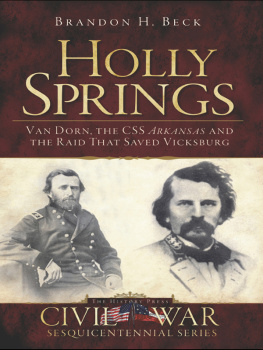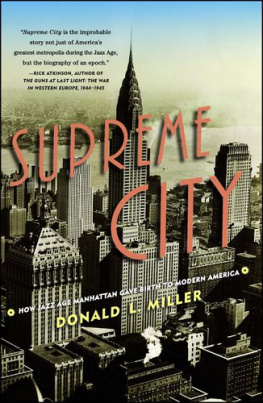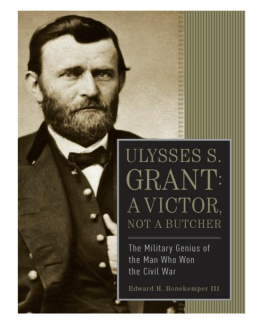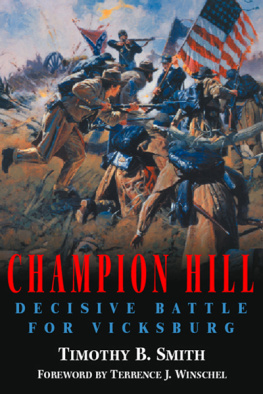This landmark series interprets broadly the history and culture of the Civil War era through the long nineteenth century and beyond. Drawing on diverse approaches and methods, the series publishes historical works that explore all aspects of the war, biographies of leading commanders, and tactical and campaign studies, along with select editions of primary sources. Together, these books shed new light on an era that remains central to our understanding of American and world history.
STORMING VICKSBURG
GRANT, PEMBERTON, and the BATTLES of MAY 1922, 1863
EARL J. HESS
THE UNIVERSITY OF NORTH CAROLINA PRESS
Chapel Hill
This book was published with the assistance of the Fred W. Morrison Fund of the University of North Carolina Press.
2020 Earl J. Hess
All rights reserved
Designed by Jamison Cockerham
Set in Arno, Scala Sans, Calt, Dear Sarah, Isherwood, and Rudyard by Tseng Information Systems, Inc.
Jacket illustrations: (front) Siege of Vicksburg, Kurz & Allison lithograph, ca. 1888; (back) Admiral Porters Fleet Running the Rebel Blockade of the Mississippi at Vicksburg, April 16th 1863, Currier & Ives lithograph. Both courtesy Library of Congress.
Manufactured in the United States of America
The University of North Carolina Press has been a member of the Green Press Initiative since 2003.
LIBRARY OF CONGRESS CATALOGING-IN-PUBLICATION DATA
Names: Hess, Earl J., author.
Title: Storming Vicksburg : Grant, Pemberton, and the Battles of May 1922, 1863 / Earl J. Hess.
Other titles: Civil War America (Series)
Description: Chapel Hill : The University of North Carolina Press, [2020] | Series: Civil War America | Includes bibliographical references and index.
Identifiers: LCCN 2020013193 | ISBN 9781469660172 (cloth : alk. paper) | ISBN 9781469660189 (ebook)
Subjects: LCSH: Vicksburg (Miss.)HistorySiege, 1863. | MississippiHistoryCivil War, 18611865Campaigns. | United StatesHistoryCivil War, 18611865Campaigns.
Classification: LCC E475.27 .H47 2020 | DDC 973.7/344dc23
LC record available at https://lccn.loc.gov/2020013193
For
PRATIBHA & JULIE
always with love
CONTENTS
PREFACE
This book is an in-depth study of a short but important phase of the long Federal campaign to capture Vicksburg, Mississippi, in the Civil War. Its focus is the period from May 18 through May 23, 1863, which serves as the end of Maj. Gen. Ulysses S. Grants overland march to the rear of the city in the first three weeks of May and the beginning of his siege. These five days were a watershed in the development of Grants eight-month-long campaign to capture the Gibraltar of the Confederacy. His hope of ending the campaign quickly by assaulting the place on May 19 and 22 was crushed by the failure of those attacks. The only recourse was a siege that extended Federal operations against Vicksburg another six weeks.
The campaign for Vicksburg, one of the longest and most important of the Civil War, falls into six distinct phases. The first Federal effort to capture the city occurred in the summer of 1862 when a combined army and navy force steamed up the Mississippi River from New Orleans only to fail due to lack of resources. The rest of the campaign for Vicksburg was directed by Grant. His first effort, the second phase of the Vicksburg campaign, involved his advance down the Mississippi Central Railroad from November 1862 until January 1863, and Maj. Gen. William T. Shermans river-borne expedition to Chickasaw Bayou in late December and early January. The Bottomlands phase of the campaign, the third in the series of efforts, occurred from late January to late April 1863 as Grants army struggled to access the high ground east of the Mississippi. Once Grant found a wayby marching along the Louisiana side and crossing the Mississippi many miles south of the Vicksburg defenseshe was able to initiate the fourth phase of Federal efforts against the city. Often called the overland march or the inland movement, Grant defeated the Confederates in five separate engagements and approached Vicksburg from the east.
Most historians consider the siege of Vicksburg to be the fifth and final phase of Union efforts against the city, but I believe it is helpful to consider the time period from May 18 to May 23 as the fifth phase, with the siege of May 23 to July 4 constituting the sixth and final period. The attacks on May 19 and 22 had the potential to end the campaign. If circumstances had been different, those days could have given Grant what he wanted: a quick victory to avoid a siege, along with several additional weeks of campaigning to clear the Confederates out of middle Mississippi. Grant thought the attacks of May 19 and 22 were promising; he intended to end the struggle for Vicksburg in one stroke by storming the town. The fact that he failed is no excuse for passing over the May 19 and 22 battles as merely a prelude to the siege.
There were several engagements yesterday which really deserve the name of battles, wrote a correspondent of the Chicago Daily Tribune on May 23. He was right. The Army of the Tennessee launched its largest tactical offensive of the war on May 22. Its officers spent more time and effort preparing for it than for any other set-piece battle they fought during the conflict. How the army conducted the attacks, and why they failed, illuminates a good deal about the history of that storied field army.
Most previous historians of the Vicksburg campaign do not delve as deeply into the details or analysis of the May 19 and 22 battles as I do in this book. Edwin C. Bearss wrote a three-volume study of the entire effort against the city entitled The Campaign for Vicksburg. In it Bearss focuses on the grand tactical perspective. He devotes five chapters out of twenty-six in the third volume to this time period, mostly using reports in the Official Records, supplemented now and then with a few other published primary sources. Michael B. Ballard has written the standard one-volume overview of the campaign, entitled Vicksburg: The Campaign that Opened the Mississippi, which does not dig as deeply into the grand tactics as Bearsss book because of space limitations. Both of these historians have contributed greatly to our understanding of the subject. A good, shorter overview can be read in William L. Shea and Terrence J. Winschels Vicksburg Is the Key. A short book on Grants handling of the operations against Vicksburg by Timothy B. Smith has a brief chapter on this phase, and an anthology of essays about this time period, edited by Steven Woodworth and Charles D. Grear, contains articles on selected aspects of the story.

Timothy B. Smith has recently written a study of the May 1922 phase of the Vicksburg campaign, The Union Assaults at Vicksburg, which appeared when Storming Vicksburg was in the copyediting phase. His objective was different from mine. Smith based his work on wide and deep research but aimed to produce a descriptive rather than an analytical text. It is consonant with an old tradition in Civil War studies, a narrative storytelling aimed at a general audience. In contrast,











